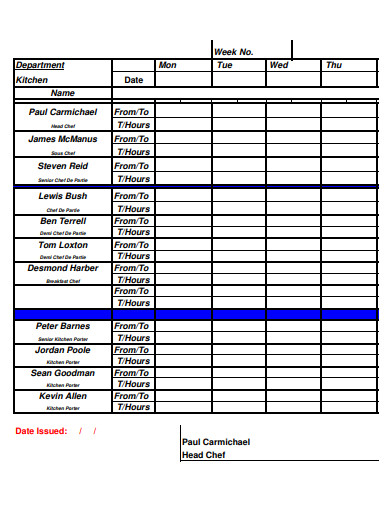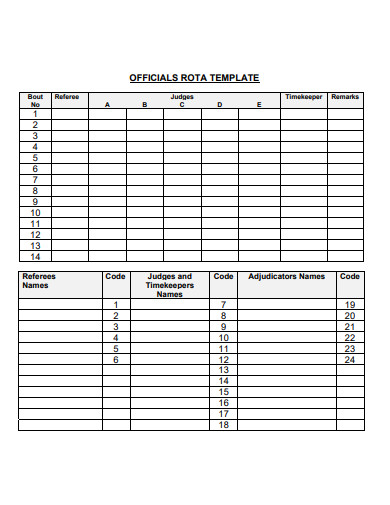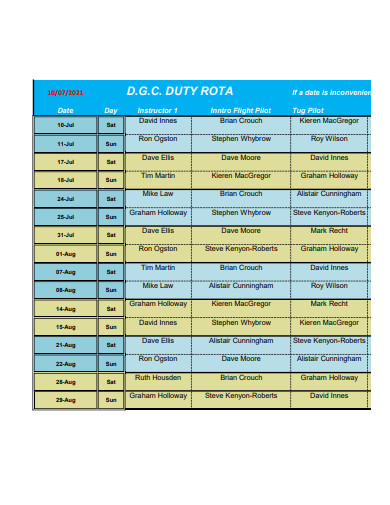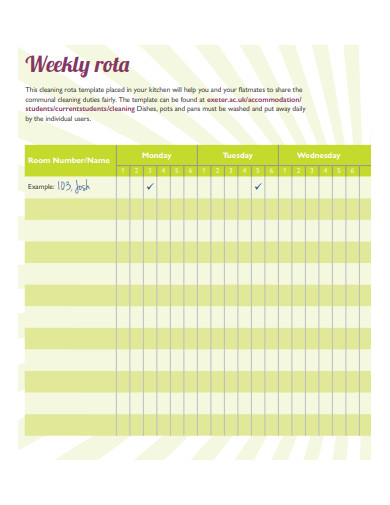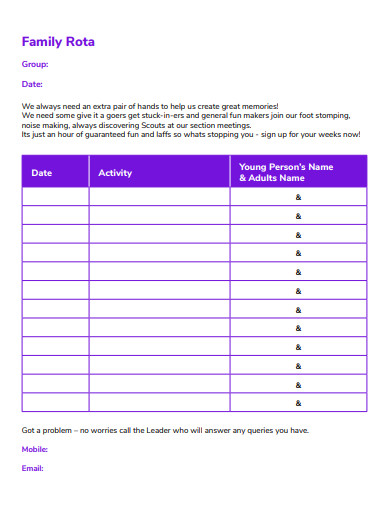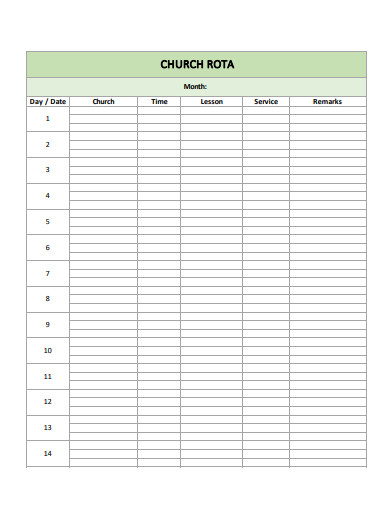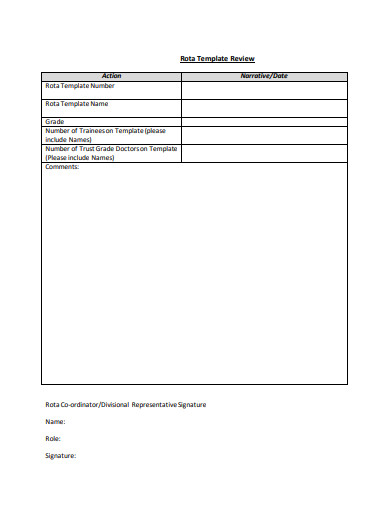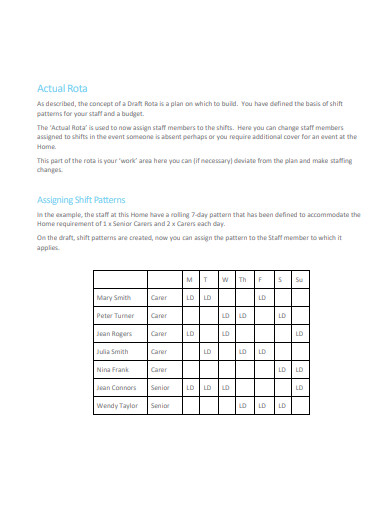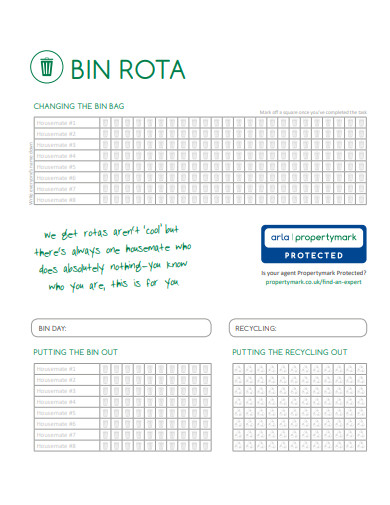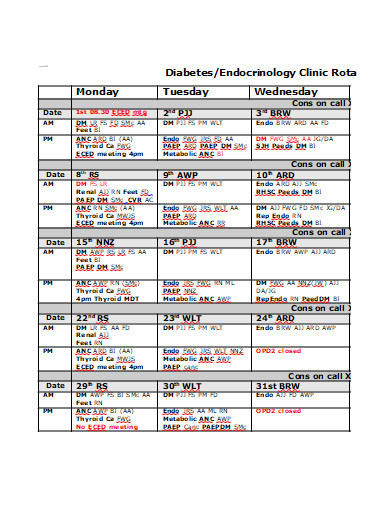Have you ever wondered how a grocery store that is open for more than eight hours per day and consistently does so manages its staff? If employees were forced to work longer than their normal shifts, this would be an unfair practice and a violation of the laws that govern the workplace. Because of this, some businesses have implemented something that is known as a rotating schedule. There are a lot of companies that require this kind of work schedule because they need to be open more than the regular hours, and others simply need an employee to stay after office hours. Both of these factors account for the majority of the companies that require it. Consider the case of a member of the security staff. Let’s talk more about this kind of schedule down below so that you can gain more knowledge about it. Check out our free rotating schedule samples that are available for download on this page if you need to get started on preparing this schedule for your employees right away.
10+ Rota Template Samples
1. Rota Template
2. Kitchen Rota
3. Offial Rota Template
4. Simple Rota
5. Weekly Rota
6. Family Rota
7. Church Rota
8. Basic Rota Template
9. Formal Rota Template
10. Cleaning Rota Template
11. Clinic Rota Template
What Is ROTA?
There are some businesses that require extended hours of operation beyond the typical nine to five schedule. Companies in the manufacturing and production sectors, as well as BPOs, restaurants, fast food chains, retail stores, logistics companies, and many others, are all examples of such businesses. In light of this, it is necessary for an employer to separate employees’ work schedules into distinct shifts, such as a morning shift and a night shift, for example. Even though some shifts are always going to be there, some businesses demand that their shifts be rotated. When an employee is asked to work a particular shift over the course of a certain time period, this is an example of a rotating schedule. And after a while, they might switch to another one depending on the schedule or if their particular expertise is needed for that role.
It is possible that rotating schedules will become monotonous for some employees, particularly those who are not accustomed to working nights. Because of this, it is essential to take control of your sleeping patterns in order to give your body the best chance of adjusting and adapting to these shifting schedules. Employees who work for businesses that have rotational schedules are given the opportunity to work a variety of shifts, which helps ensure that everyone gets a fair shake. Aside from that, being able to work across all shifts as an employee will allow you to acquire a comprehensive understanding of the duties and responsibilities associated with your position.
How to Prepare a ROTA
When you work on a rotating schedule, you might be able to reap some benefits. Consider, for instance, those who work in restaurants; rotating shifts provide each employee with the opportunity to earn more money in tips during shifts that are characterized by high customer volume. Aside from that, this would prevent employees from becoming bored at work, increase their engagement, and assist them in gaining more experience. A rotating shift is advantageous for employers because it allows workers to become accustomed to shifting work schedules. As a result, workers can more easily adapt to unforeseen shift adjustments and are better prepared to respond to changing work demands.
You need to take into consideration a number of different factors before you are able to finalize the work schedule and the employees that are to work on that particular schedule. Rotating schedules can make initial planning a bit more complicated than it needs to be. However, after some time, when you have gotten into the habit of doing this frequently, you will be able to easily organize rotational schedules for your employees. In order to assist you in the preparation of this schedule, here are several procedures that you need to keep in mind.
- Types of Rota
First, you should know that there are different kinds of rotating schedules from which you can choose and change.- Dupont Shift Schedule – this features a 12-hour, four-week cycle: four-night shifts, three days off, three-day shifts, one day off, three-night shifts, three days off, four-day shifts, and seven days off. This kind of method benefits employees because they have a built-in, week-long vacation every month.
- Pitman Shift Schedule – is built so that an employee can have every other weekend off. Within a 14-day period, employees work two days on, two days off, three days on, two days off, two days on, and three days off.
- The 2-2-3-2 2-3 Rotating Shift – this is when an employee is required to work day or night shifts exclusively for two weeks and then switch to the opposite shift for the next two weeks.Choosing the right rotating schedule depends on the type of business you run and, more importantly, the skills and knowledge of the people who work for you.
- Divide your employees into teams
Divide your employees into teams so you can figure out who goes to each shift. When doing this, it’s important that every member of each team can run the business well during their shift. One team should have enough people who can do every job that needs to be done per shift. - Determine the rotation
Choose the type of rotating schedule that works best for your business. You can use one type or a mix of several. If your company has never done this before, you can try it out and see how it goes. - Monitor
You need to keep a close eye on your employees and how they do each shift. This will help you figure out how well they are working and if there are any problems that are stopping them from making as much money as they could. Aside from the hours, it’s important to figure out if the people on that team can work well together. Even so, in some businesses, having a group of people on the same shift doesn’t mean they have to work together because they may each have their own tasks. But people who work in the food business or in manufacturing need to work together. If people are complaining or if it’s getting in the way of work, you may need to switch up not only the schedule but also the people on the team.
FAQs
What’s the most over time you can work?
There is no specific time, as long as you get paid for your work and the company lets you do it. It’s important to ask your boss how overtime works at your company, since each business may have its own rules.
Can an employer change your work hours without consent?
Yes, they can change your work hours without asking you first, but they have to let you know before you start work so you can get ready. If you don’t agree with the changes, you can talk more about it with your immediate boss.
What is a Fixed Schedule?
When a group of people always work the same shift and don’t need to switch, this is called a “fixed schedule.”
One type of work schedule is a rotating schedule, in which employees are asked to change their shifts over a certain amount of time. It happens a lot in industries that need people to work outside of their regular hours. Download our free templates now to make making this schedule easier.
Related Posts
FREE 10+ Check Off List Samples in PDF
FREE 10+ Shipping Packing List Samples in PDF
FREE 7+ Rreferences List Samples in PDF
FREE 10+ Daily to do List Sample in PDF
FREE 10+ Tier List Samples in PDF
FREE 10+ Subcontractor List Samples in PDF | DOC
FREE 10+ Grocery Shopping List Samples in MS Word | Google Docs | PDF
FREE 10+ Child Care Waiting List Samples in PDF
FREE 10+ Professional Contact List Samples in PDF | MS Word | Google Docs
FREE 10+ Emergency Contact List Samples in PDF
FREE 10+ Santa List Samples in PDF
FREE 10+ Travel Packing List Samples in PDF
FREE 10+ Birthday Wish List Samples in PDF
FREE 10+ To-Do List Samples in PDF
FREE 10+ Vacation Packing List Samples in PDF


